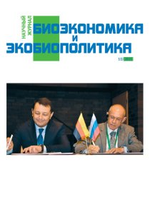Nitrosyl non Heme Proteins Mimetics as New Agents for Cancer Chemotherapy
Автор: Санина Н. А.
Рубрика: Тезисы
Опубликовано в Биоэкономика и экобиополитика №1 (1) декабрь 2015 г.
Дата публикации: 15.01.2016
Статья просмотрена: 7 раз
Библиографическое описание:
Санина, Н. А. Nitrosyl non Heme Proteins Mimetics as New Agents for Cancer Chemotherapy / Н. А. Санина. — Текст : непосредственный // Биоэкономика и экобиополитика. — 2015. — № 1 (1). — URL: https://moluch.ru/th/7/archive/20/644/ (дата обращения: 25.04.2025).
The search for new approaches to the development of effective and non-toxic prodrugs based on metal coordination compounds has been performed intensely in leading laboratories world-wide.
It is known that nitrosyl iron complexes are intermediates in the decomposition of proteins and formation of S-nitrosothiols, which are catalyzed by the iron, and are reservoirs and transporters of nitric oxide (NO) in vivo. Based on these data, methods for synthesis and investigation of properties (X-ray analysis, IR-, EPR, Mössbauer spectroscopy, SQUID magnetometry and amperometry (NO donating activity)) of nitrosyl [2Fe2S] and [1Fe-2S] ferredoxins mimetics have been developed, with the aim to use them as NO donors in the in the treatment of NO-chemotherapy of oncological diseases. High anticancer activity in vitro and in vivo has been first shown for a series of binuclear tetranitrosyl iron complexes. Functional sulfur-containing ligands in such complexes are reversible inhibitors for synthesis of cellular DNA, and they suppress the growth of tumors of various genesis, while the NO group, being the second component of the hybrid complex, is a key signal molecule that controls the tumor growth. All studied binuclear tetranitrosyl iron complexes were shown to be inductors of apoptosis in tumor cells. High anticancer activity of some nitrosyl iron complexes was detected on mice’s transplantable tumors.
A water-soluble моnоnuclear dinitrosyl iron complexes (DNICs) with thiourea and Nethylthiourea have been synthesized and studied for the first time. They were shown to be less toxic (almost ten times) than the anticancer agents of the platinum group – cis-platin and satraplatin – studied earlier, their activity being the same. HeLa cells have been shown to be much more sensitive to DNICs than MCF7 cells, a response similar to that observed for the platinum complexes. The mechanisms of the cytotoxic effect of the nitrosyl complexes, as well as the reduced sensitivity of MCF7 cells to the effects of the NO donor of this class, should be examined additionally.







